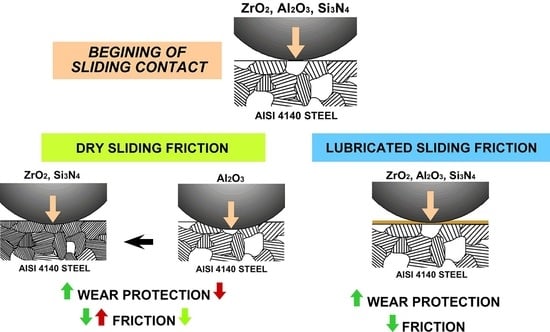On the Influence of Tribological Properties of AISI 4140 Annealed Steel against Ceramic Counterparts under Dry and Lubricated Conditions and Their Effect on Steel Microstructure
Abstract
:1. Introduction
2. Materials and Methods
2.1. Disk and Pin Materials
2.2. Microstructure Characterization of the AISI 4140 Annealed Steel
2.3. Friction and Wear Investigation
2.4. Microhardness Measurements
2.5. Lubrication Regime Estimation
3. Results
3.1. Microstructure of the AISI 4140 Annealed Steel
3.2. Tribological Behavior of AISI 4140 Annealed Steel against Ceramics in Dry Conditions
3.2.1. Friction Behavior
3.2.2. Wear Mechanisms
3.2.3. Wear Behavior
3.2.4. Effect on Microhardness Behavior
3.3. Microstructure and Tribological Behavior of Hardened and Tempered AISI 4140 Steel against ZrO2 in Dry Conditions
3.4. Tribological Behavior of AISI 4140 Annealed Steel against Ceramics in Lubricated Conditions
3.4.1. Friction Behavior
3.4.2. Wear Mechanisms
3.4.3. Wear Behavior
3.4.4. Lubricating Regimes
4. Discussion
5. Conclusions
Supplementary Materials
Author Contributions
Funding
Data Availability Statement
Acknowledgments
Conflicts of Interest
Appendix A
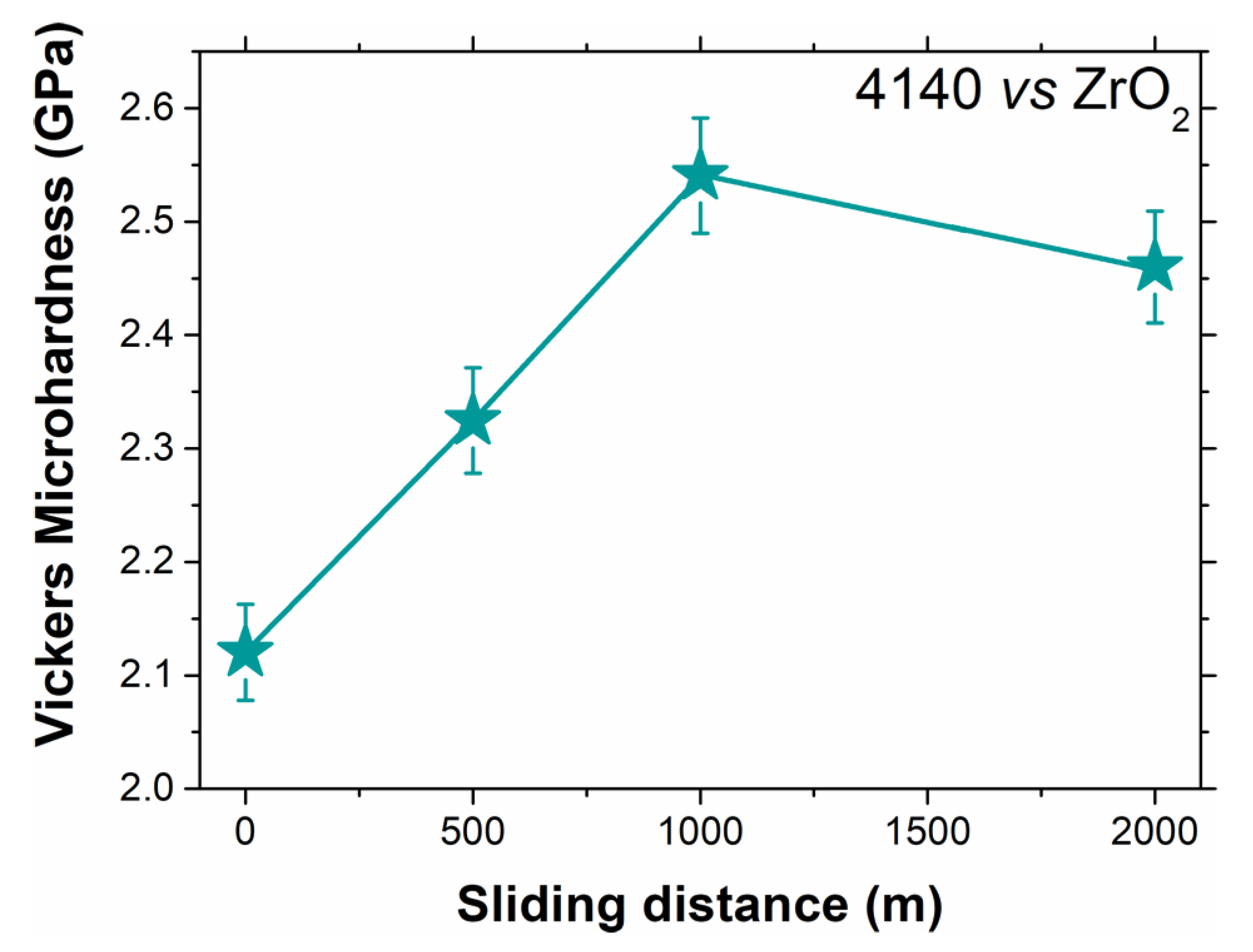
References
- Ulutan, M.; Celik, O.N.; Gasan, H.; Er, Ü. Effect of Different Surface Treatment Methods on the Friction and Wear Behavior of AISI 4140 Steel. J. Mater. Sci. Technol. 2010, 26, 251–257. [Google Scholar] [CrossRef]
- Singh, H.; Singla, Y.K.; Singh, A.K.; Chattopadhayay, K. Effect of Nanofly Ash as Lubricant Additive on the Tribological Properties of SAE 10W-30 Oil: A Novel Finding. Trans. Indian Inst. Met. 2020, 73, 1–5. [Google Scholar] [CrossRef]
- Hafeez, M.A.; Farooq, A. Effect of Heat Treatments on the Mechanical and Electrochemical Corrosion Behavior of 38CrSi and AISI 4140 Steels. Met. Microstruct. Anal. 2019, 8, 479–487. [Google Scholar] [CrossRef]
- Totik, Y.; Sadeler, R.; Altun, H.; Gavgali, M. The effects of induction hardening on wear properties of AISI 4140 steel in dry sliding conditions. Mater. Des. 2003, 24, 25–30. [Google Scholar] [CrossRef]
- Meysami, A.; Ghasemzadeh, R.; Seyedein, S.; Aboutalebi, M. An investigation on the microstructure and mechanical properties of direct-quenched and tempered AISI 4140 steel. Mater. Des. 2010, 31, 1570–1575. [Google Scholar] [CrossRef]
- Das, S.R.; Dhupal, D.; Kumar, A. Experimental investigation into machinability of hardened AISI 4140 steel using TiN coated ceramic tool. Measurement 2015, 62, 108–126. [Google Scholar] [CrossRef]
- Badaruddin, M.; Wardono, H.; Wang, C.J.; Rivai, A.K. Improvement of low-cycle fatigue resistance in AISI 4140 steel by annealing treatment. Int. J. Fatigue 2019, 125, 406–417. [Google Scholar] [CrossRef]
- Sharma, S.; Kini, V. Effect of heat treatment and mechanical characterization of AISI 4140 steel. IJMPERD 2018, 8, 603–610. [Google Scholar]
- Wang, C.; Ye, Y.; Guan, X.; Hu, J.; Wang, Y.; Li, J. An analysis of tribological performance on Cr/GLC film coupling with Si3N4, SiC, WC, Al2O3 and ZrO2 in seawater. Tribol. Int. 2016, 96, 77–86. [Google Scholar] [CrossRef]
- Xu, S.; Xu, Y.; Liu, Y.; Fang, M.; Wu, X.; Min, X.; Zhang, X.; Huang, Z. Fabrication and abrasive wear behaviour of Zr-SiC-Al2O3 ceramic. Ceram. Int. 2017, 43, 15060–15067. [Google Scholar] [CrossRef]
- Liu, C.; Sun, J. Effect of load on friction and wear behaviors of alumina matrix ceramic guideway materials. J. Alloy. Compd. 2018, 743, 268–273. [Google Scholar] [CrossRef]
- Yan, S.; Wei, C.; Zou, H.; Chen, J.; Li, Y.; Shen, T.; Wang, A.; Sui, T.; Lin, B. Fabrication and tribological characterization of laser textured engineering ceramics: Si3N4, SiC and ZrO2. Ceram. Int. 2021, 47, 13789–13805. [Google Scholar] [CrossRef]
- Rowthu, S.; Deshpande, P.; Annamalai, A.; Hoffmann, P. Harnessing nano oil reservoir network for generating low friction and wear in self-mating alumina. Mater. Des. 2021, 206, 109821. [Google Scholar] [CrossRef]
- Stachowiak, G.W.; Batchelor, A.W. Wear of Non-Metallic Materials. In Engineering Tribology, 4th ed.; Stachowiak, G.W., Batchelor, A.W., Eds.; Butterworth-Heinemann: Waltham, MA, USA, 2014; pp. 679–734. [Google Scholar]
- Hernández-Sierra, M.T.; Aguilera-Camacho, L.D.; Báez-García, J.E.; García-Miranda, J.S.; Moreno, K.J. Thermal Stability and Lubrication Properties of Biodegradable Castor Oil on AISI 4140 Steel. Metals 2018, 8, 428. [Google Scholar] [CrossRef] [Green Version]
- ASTM. Standard G 99–05. Standard Test Method for Wear Testing with a Pin-on-Disk Apparatus. ASTM Int. 2005, 1–5.
- Hamrock, B.J.; Dowson, D. Isothermal Elastohydrodynamic Lubrication of Point Contacts: Part 111-FullyFlooded Results. J. Lubr. Technol. 1977, 99, 264–275. [Google Scholar] [CrossRef]
- Hernández-Sierra, M.T.; Bravo-Sánchez, M.G.; Báez, J.E.; Aguilera-Camacho, L.D.; García-Miranda, J.S.; Moreno, K.J. Improvement Effect of Green Lubricants on the Tribological and Mechanical Performance of 4140 Steel. Appl. Sci. 2019, 9, 4896. [Google Scholar] [CrossRef] [Green Version]
- Abdelbary, A. Extreme Tribology: Fundamentals and Challenges, 1st ed.; Abdelbary, A., Ed.; CRC Press: Boca Raton, FL, USA, 2020; pp. 73–140. [Google Scholar]
- Kato, K. Classification of wear mechanisms/models. Proc. Inst. Mech. Eng. Part J. J. Eng. Tribol. 2002, 216, 349–355. [Google Scholar] [CrossRef]
- Rojacz, H.; Mozdzen, G.; Weigel, F.; Varga, M. Microstructural changes and strain hardening effects in abrasive contacts at different relative velocities and temperatures. Mater. Charact. 2016, 118, 370–381. [Google Scholar] [CrossRef]
- Sohi, M.H.; Ebrahimi, M.; Raouf, A.H.; Mahbouibi, F. Effect of plasma nitrocarburizing tempertaure on the wear behavior of AISI 4140 Seel. Surf. Coat. Tech. 2010, 205, 584–589. [Google Scholar]
- Lorenzo-Martin, C.; Ajayi, O.O. Rapid surface hardening and enhanced tribological performance of 4140 steel by friction stir processing. Wear 2015, 332–333, 962–970. [Google Scholar] [CrossRef] [Green Version]
- Stachowiak, G.W.; Batchelor, A.W. Fundamentals of Contact Between Solids. In Engineering Tribology, 4th ed.; Stachowiak, G.W., Batchelor, A.W., Eds.; Butterworth-Heinemann: Waltham, MA, USA, 2014; pp. 475–524. [Google Scholar]
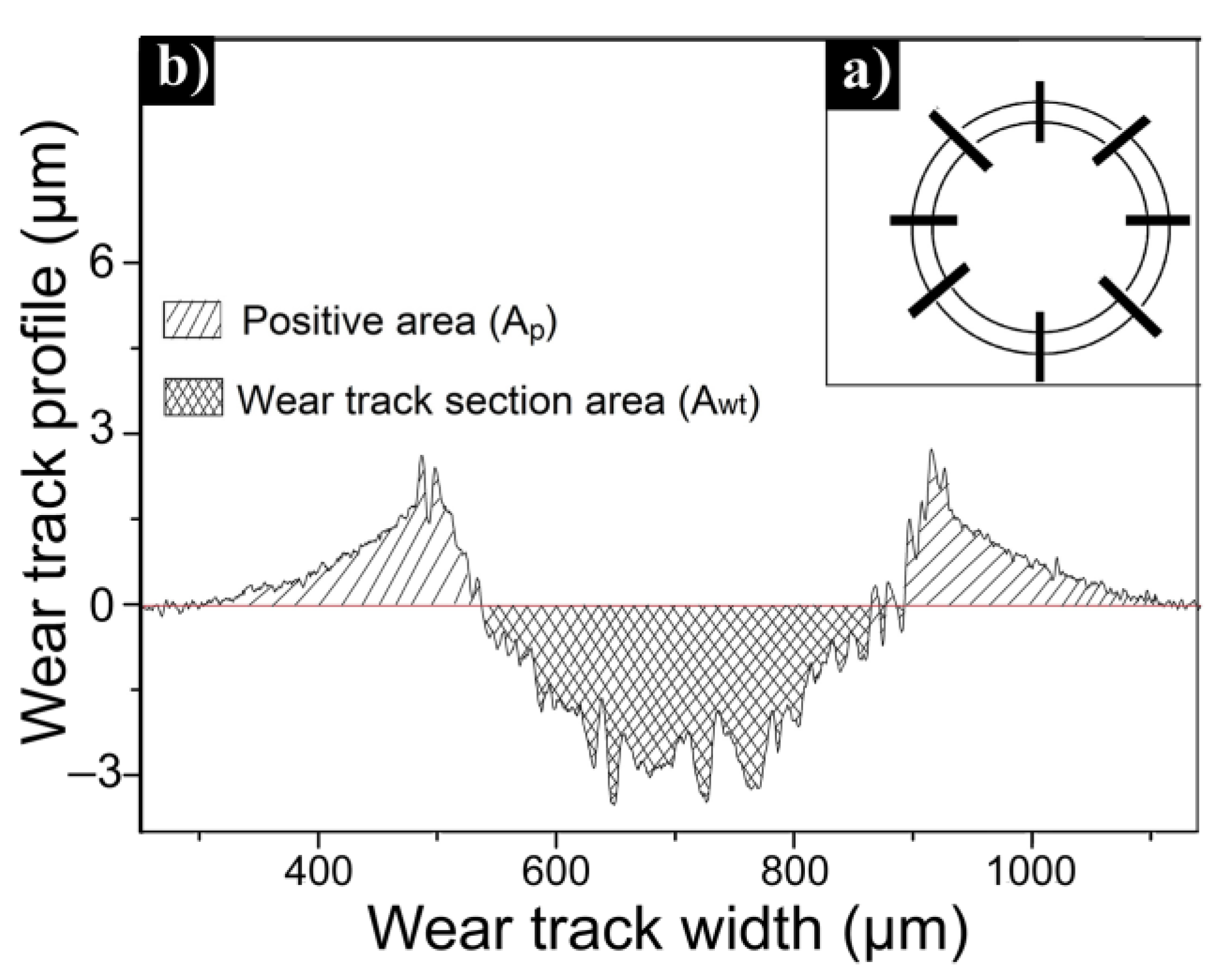
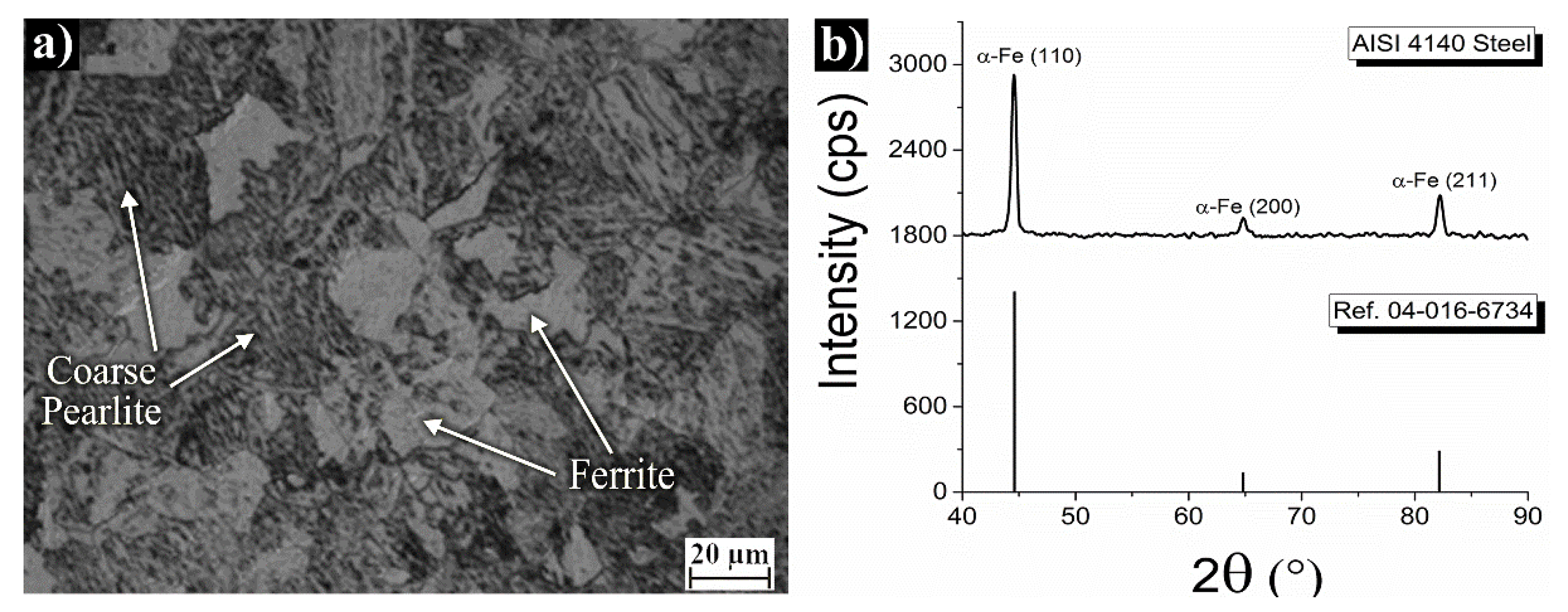
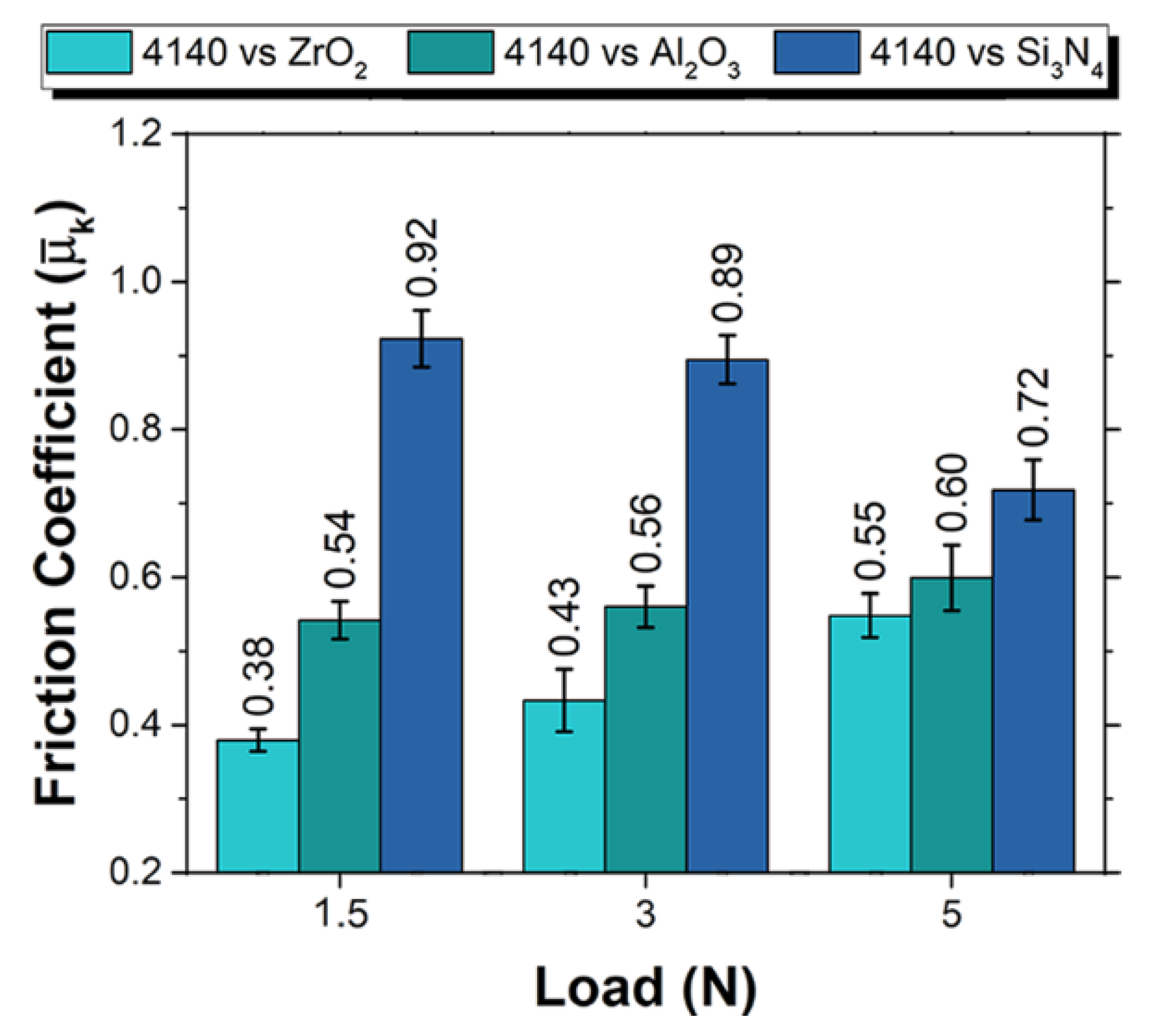
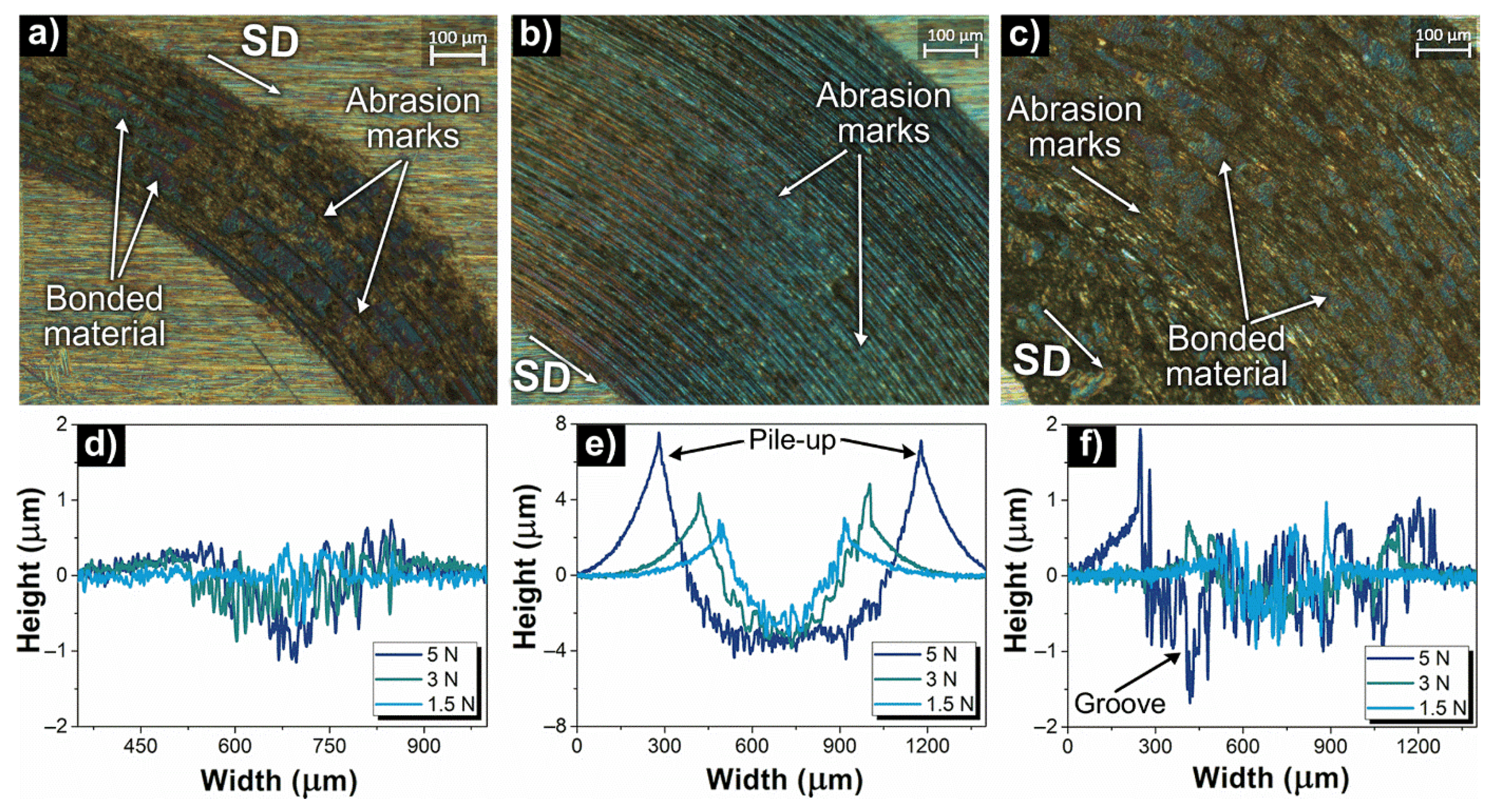
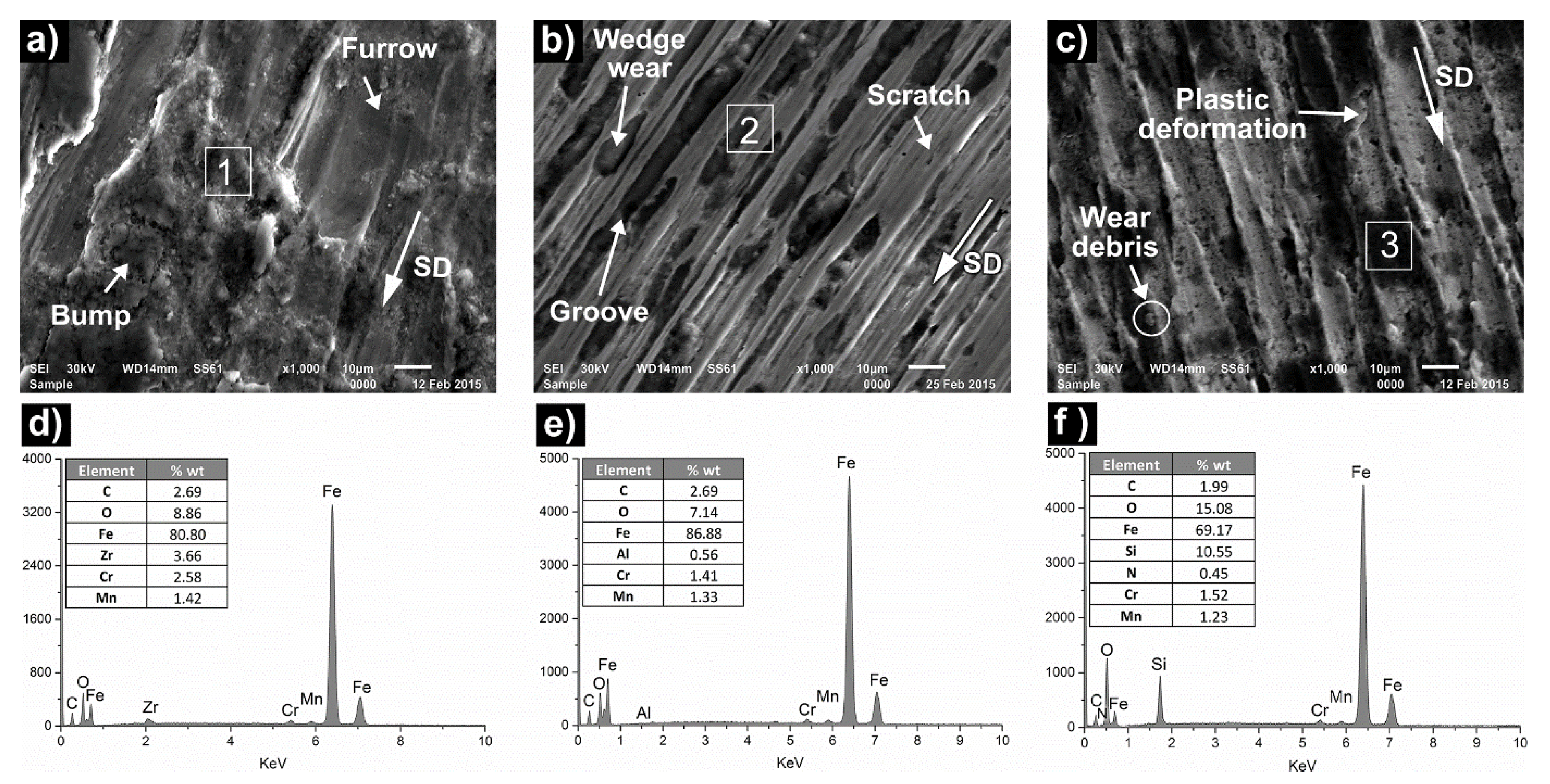
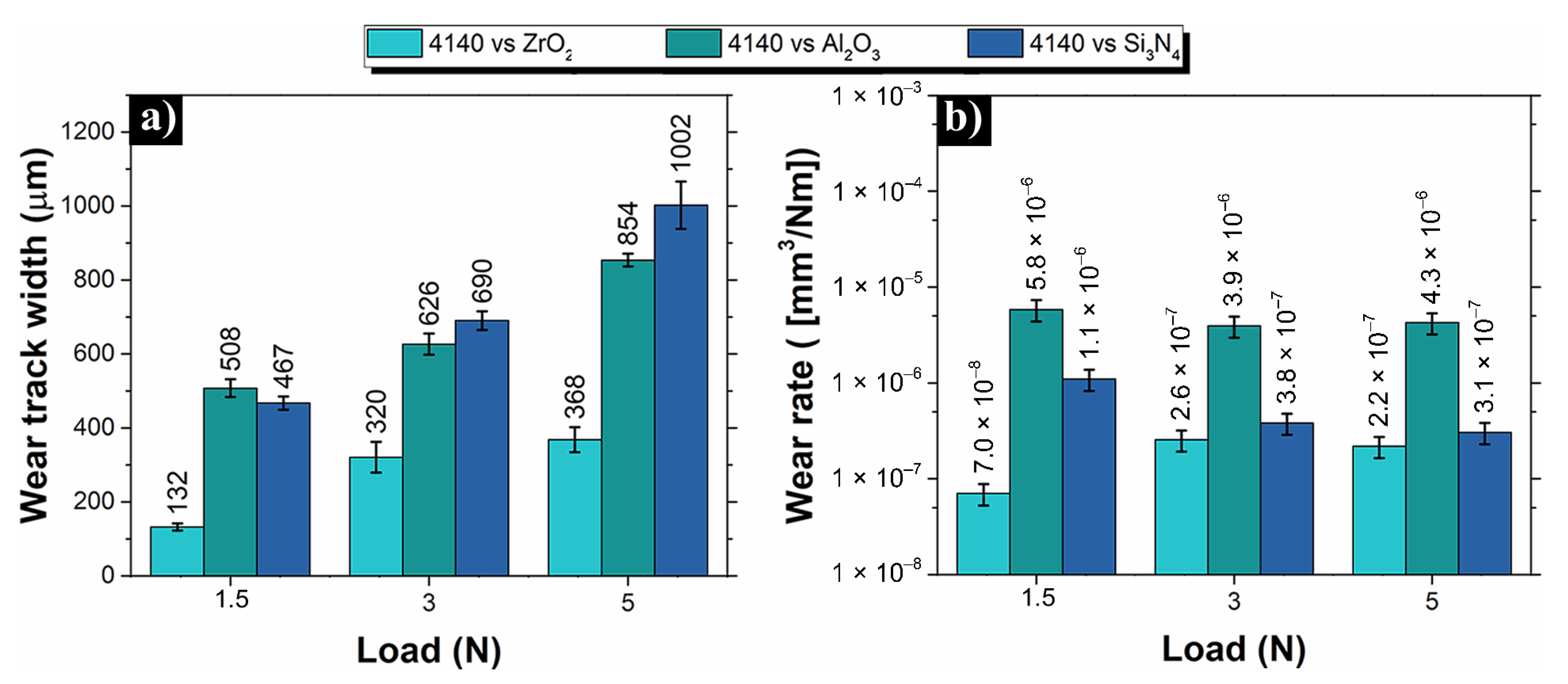
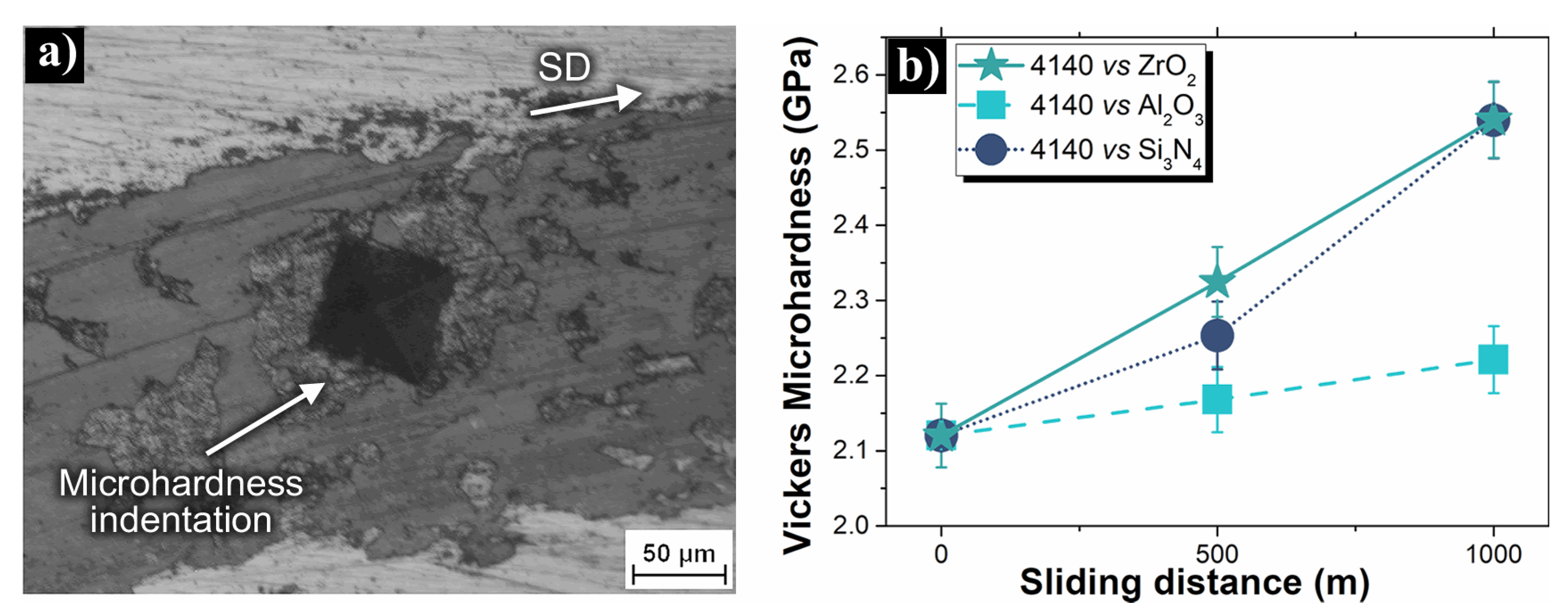

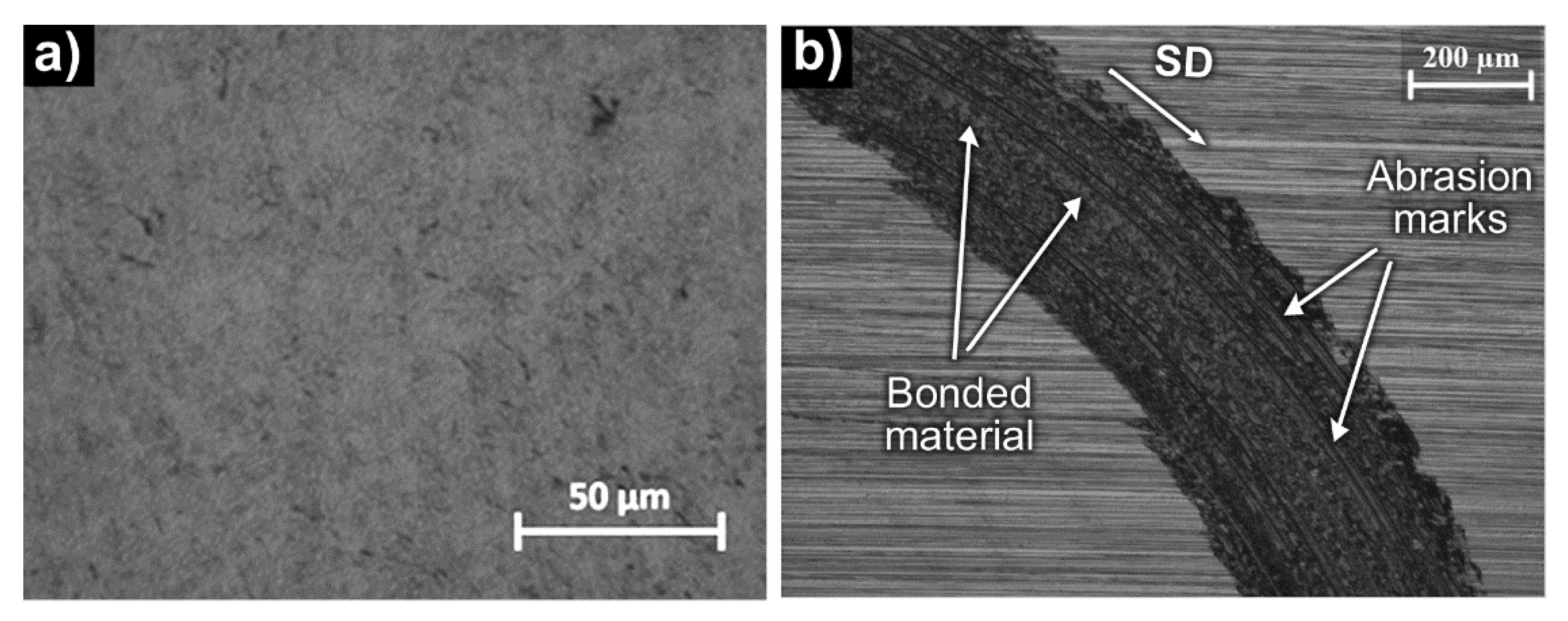

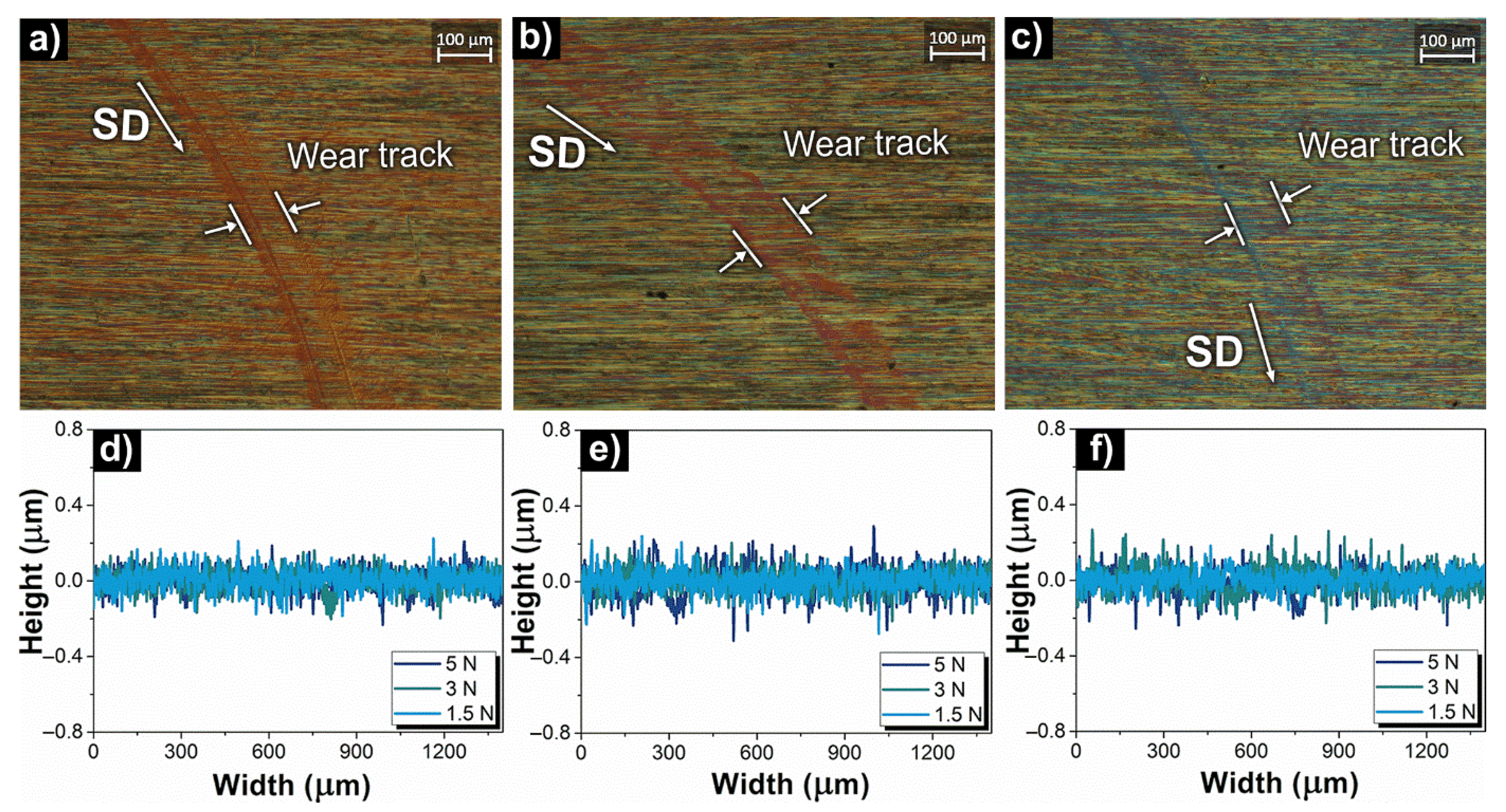
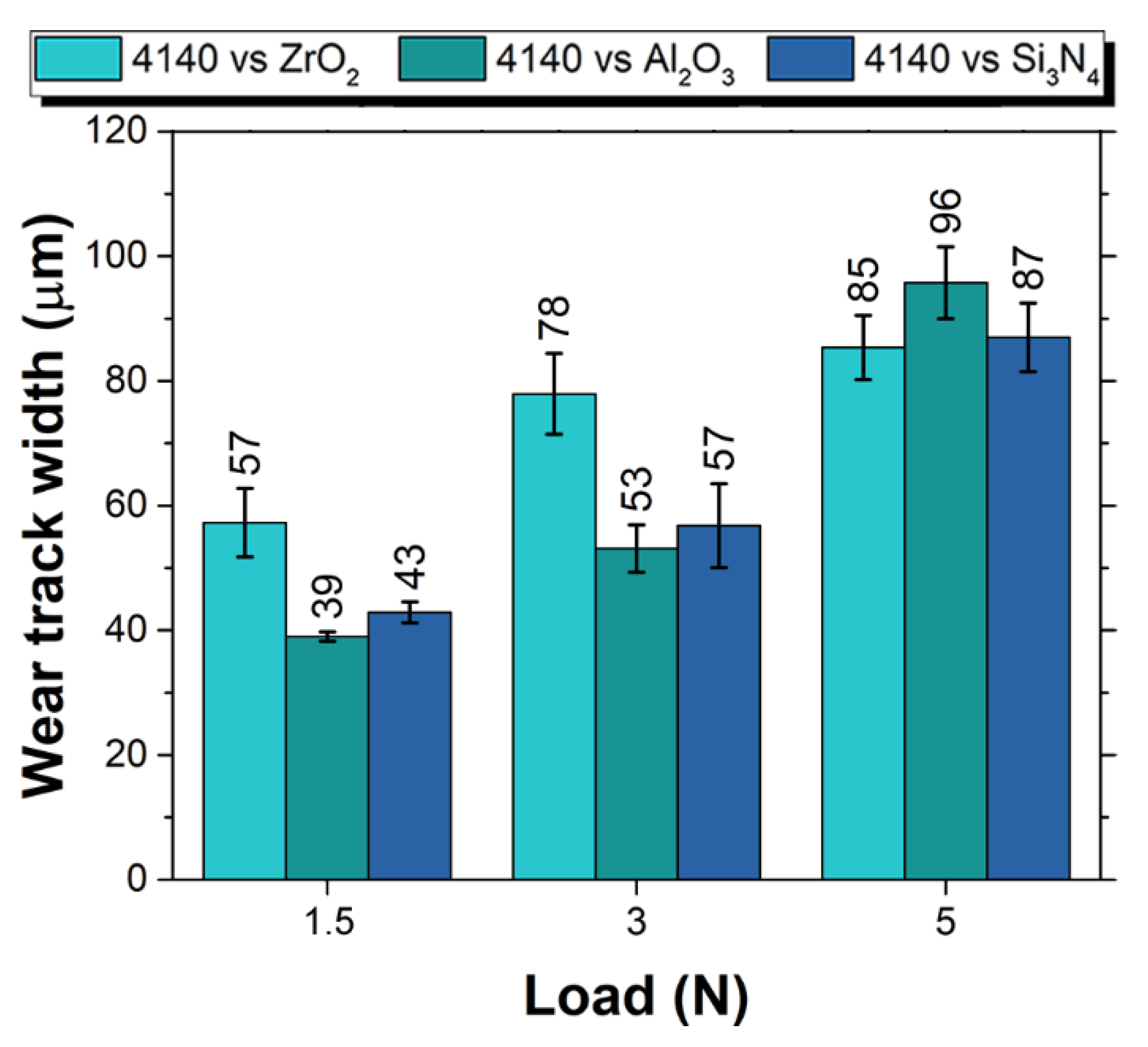
| %C | %Mn | %Cr | %Mo | %Si | %P | %S | %Fe |
|---|---|---|---|---|---|---|---|
| 0.38–0.43 | 0.76–1.00 | 0.80–1.10 | 0.15–0.25 | 0.15–0.35 | 0.035 max. | 0.04 max. | Balance |
| Material | Vickers Micro- Hardness (GPa) a | Tensile Strength Ultimate (MPa) b | Fracture Toughness (MPa.m1/2) b | Modulus of Elasticity (GPa) b | Poisson’s Ratio, ν b |
|---|---|---|---|---|---|
| AISI 4140 | 2.08–2.16 | 850–1000 | 117–123 | 210 | 0.27 |
| ZrO2 | 12.43–12.93 | 200–350 | 7–13 | 200 | 0.23–0.3 |
| Al2O3 | 20.65–21.49 | 200–300 | 2–3 | 300–400 | 0.23–0.25 |
| Si3N4 | 13.22–13.22 | 200–350 | 3.5–5 | 280–310 | 0.21–0.25 |
| Counterpart | Hertz Contact Pressure (MPa) | |||||
|---|---|---|---|---|---|---|
| 1.5 N | 3 N | 5 N | ||||
| pm | pmax | pm | pmax | pm | pmax | |
| ZrO2 | 490 | 730 | 610 | 920 | 720 | 1090 |
| Al2O3 | 550 | 830 | 690 | 1040 | 820 | 1230 |
| Si3N4 | 550 | 830 | 700 | 1050 | 830 | 1240 |
| Kinetic Friction Coefficient | Wear Track Width (µm) | HV in the Worn Surface after 1000 m (GPa) | |||
|---|---|---|---|---|---|
| mean | std. dev. | mean | std. dev. | mean | std. dev. |
| 0.47 | 0.04 | 309 | 39 | 4.80 | 0.16 |
| Counterpart | Load | H | λ | ||
|---|---|---|---|---|---|
| c | min | C | min | ||
| N | nm | nm | Nm | nm | |
| ZrO2 | 1.5 | 168 | 94 | 3.4 | 1.9 |
| 3 | 160 | 89 | 3.2 | 1.8 | |
| 5 | 155 | 86 | 3.1 | 1.7 | |
| Al2O3 | 1.5 | 166 | 92 | 3.3 | 1.8 |
| 3 | 158 | 87 | 3.2 | 1.7 | |
| 5 | 153 | 84 | 3.1 | 1.7 | |
| Si3N4 | 1.5 | 166 | 92 | 3.3 | 1.8 |
| 3 | 158 | 87 | 3.2 | 1.7 | |
| 5 | 153 | 84 | 3.1 | 1.7 | |
Publisher’s Note: MDPI stays neutral with regard to jurisdictional claims in published maps and institutional affiliations. |
© 2021 by the authors. Licensee MDPI, Basel, Switzerland. This article is an open access article distributed under the terms and conditions of the Creative Commons Attribution (CC BY) license (https://creativecommons.org/licenses/by/4.0/).
Share and Cite
Aguilera-Camacho, L.D.; Hernández-Sierra, M.T.; García-Miranda, J.S.; Moreno, K.J. On the Influence of Tribological Properties of AISI 4140 Annealed Steel against Ceramic Counterparts under Dry and Lubricated Conditions and Their Effect on Steel Microstructure. Metals 2021, 11, 1275. https://doi.org/10.3390/met11081275
Aguilera-Camacho LD, Hernández-Sierra MT, García-Miranda JS, Moreno KJ. On the Influence of Tribological Properties of AISI 4140 Annealed Steel against Ceramic Counterparts under Dry and Lubricated Conditions and Their Effect on Steel Microstructure. Metals. 2021; 11(8):1275. https://doi.org/10.3390/met11081275
Chicago/Turabian StyleAguilera-Camacho, Luis D., María T. Hernández-Sierra, J. Santos García-Miranda, and Karla J. Moreno. 2021. "On the Influence of Tribological Properties of AISI 4140 Annealed Steel against Ceramic Counterparts under Dry and Lubricated Conditions and Their Effect on Steel Microstructure" Metals 11, no. 8: 1275. https://doi.org/10.3390/met11081275
APA StyleAguilera-Camacho, L. D., Hernández-Sierra, M. T., García-Miranda, J. S., & Moreno, K. J. (2021). On the Influence of Tribological Properties of AISI 4140 Annealed Steel against Ceramic Counterparts under Dry and Lubricated Conditions and Their Effect on Steel Microstructure. Metals, 11(8), 1275. https://doi.org/10.3390/met11081275







